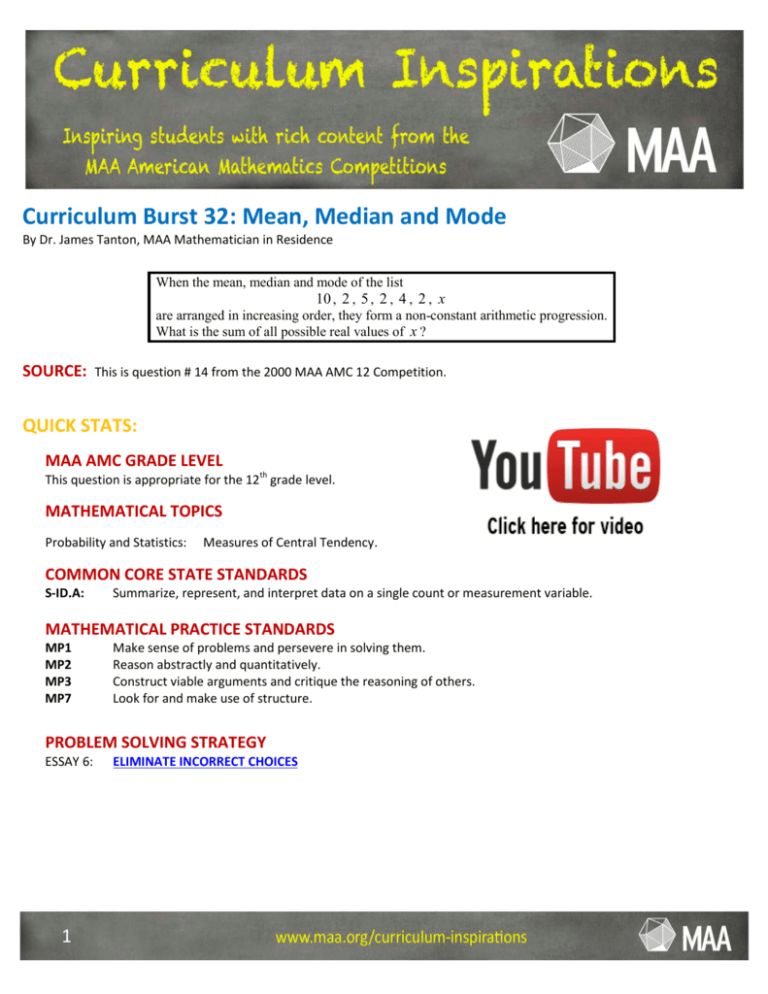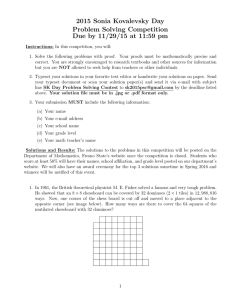Curriculum Burst 32: Mean, Median and Mode
advertisement

Curriculum Burst 32: Mean, Median and Mode By Dr. James Tanton, MAA Mathematician in Residence When the mean, median and mode of the list 10 , 2 , 5 , 2 , 4 , 2 , x are arranged in increasing order, they form a non-constant arithmetic progression. What is the sum of all possible real values of x ? SOURCE: This is question # 14 from the 2000 MAA AMC 12 Competition. QUICK STATS: MAA AMC GRADE LEVEL This question is appropriate for the 12th grade level. MATHEMATICAL TOPICS Probability and Statistics: Measures of Central Tendency. COMMON CORE STATE STANDARDS S-ID.A: Summarize, represent, and interpret data on a single count or measurement variable. MATHEMATICAL PRACTICE STANDARDS MP1 MP2 MP3 MP7 Make sense of problems and persevere in solving them. Reason abstractly and quantitatively. Construct viable arguments and critique the reasoning of others. Look for and make use of structure. PROBLEM SOLVING STRATEGY ESSAY 6: 1 ELIMINATE INCORRECT CHOICES THE PROBLEM-SOLVING PROCESS: As always … with a non-zero “step size” from a to b , and then the same step size from b to c . STEP 1: Read the question, have an emotional reaction to it, take a deep breath, and then reread the question. Okay … I can handle that. Let’s look at our three numbers and see when we can make this happen! The feature of this question that makes me feel uneasy is the vocabulary: mean, median, mode, and even arithmetic progression. I need to get the meaning of these words back in my head. Mean is “average,” and the average of these seven data is: Mean 10 + 2 + 5 + 2 + 4 + 2 + x 25 + x . = 7 7 I remember mode is the most frequent data point. Without even knowing the value of x , it is clear that “ 2 ” occurs the most times. Mode = 2 . I have a faint memory that median is the middle number of the data set, but you need to first arrange the data in order. The best I can do to order the numbers for now is to write: 2 2 2 4 5 10 , and also x If x is between 2 and 4 , then x will be the middle number. (This is true even if x = 2 or if x = 4 .) If x < 2 , then 2 would be the middle number, and if x > 4 , then 4 is at the middle. So we have: x if 2 ≤ x ≤ 4 Mean 2 if x < 2 . = 4 if x > 4 Umm, what was the question? The mean, median and mode make a (non-constant) arithmetic progression. What does that mean? Okay, I remember that a sequence whose entries increase from term to term by a constant amount (such as 4, 7,10,13,16,... ) is an arithmetic progression. (And I guess “non-constant” means sequences like 4, 4, 4, 4, 4,... which increase by zero from term to term are not allowed.) We want the mean, median and mode to form a non-constant arithmetic progression. That is, they need to constitute a set of three numbers a b c This question naturally splits into three cases. 25 + x and 2 and 7 CASE x < 2 : Our three numbers are 2 . These can’t be in non-constant arithmetic progression! This case is out! CASE x > 4 : Our three numbers are 25 + x and 2 and 4 . 7 25 + x could be 0 or 3 or 6 , meaning x could be 7 −25 or −4 or 17 . Only x = 17 has x > 4 . Okay, CASE 2 ≤ x ≤ 4 : Our three numbers are 25 + x and 2 7 and x . Hmm. This seems too “loose” to pin down. What can we do? Well, we do have that x is greater than 2 , so either 2 < x < 25 + x 25 + x or 2 < < x . And we need 7 7 the same “step size” for each. In the first situation this means x = −2 25 + x − x , giving 7 39 = 3 . The second 13 25 + x 25 + x scenario requires , yielding −2= x− 7 7 36 2 ( 25 + x ) = 7 x + 14 giving = x > 4 . Not possible. 5 x 7 x − 14 = 25 + x − 7 x and = So only x = 17 and x = 3 give the desired result, and their sum is 20 ! Extension: a) Find five data values with median = 10 , mode = 10 , mean = 1000 . b) Find five data values with median = 10 , mode = 1000 , mean = 10 . c) Can you find five data values with median = 1000 , mode = 10 , mean = 10 ? d) Repeat the previous three parts for SIX data values! Curriculum Inspirations is brought to you by the Mathematical Association of America and MAA American Mathematics Competitions. 2






